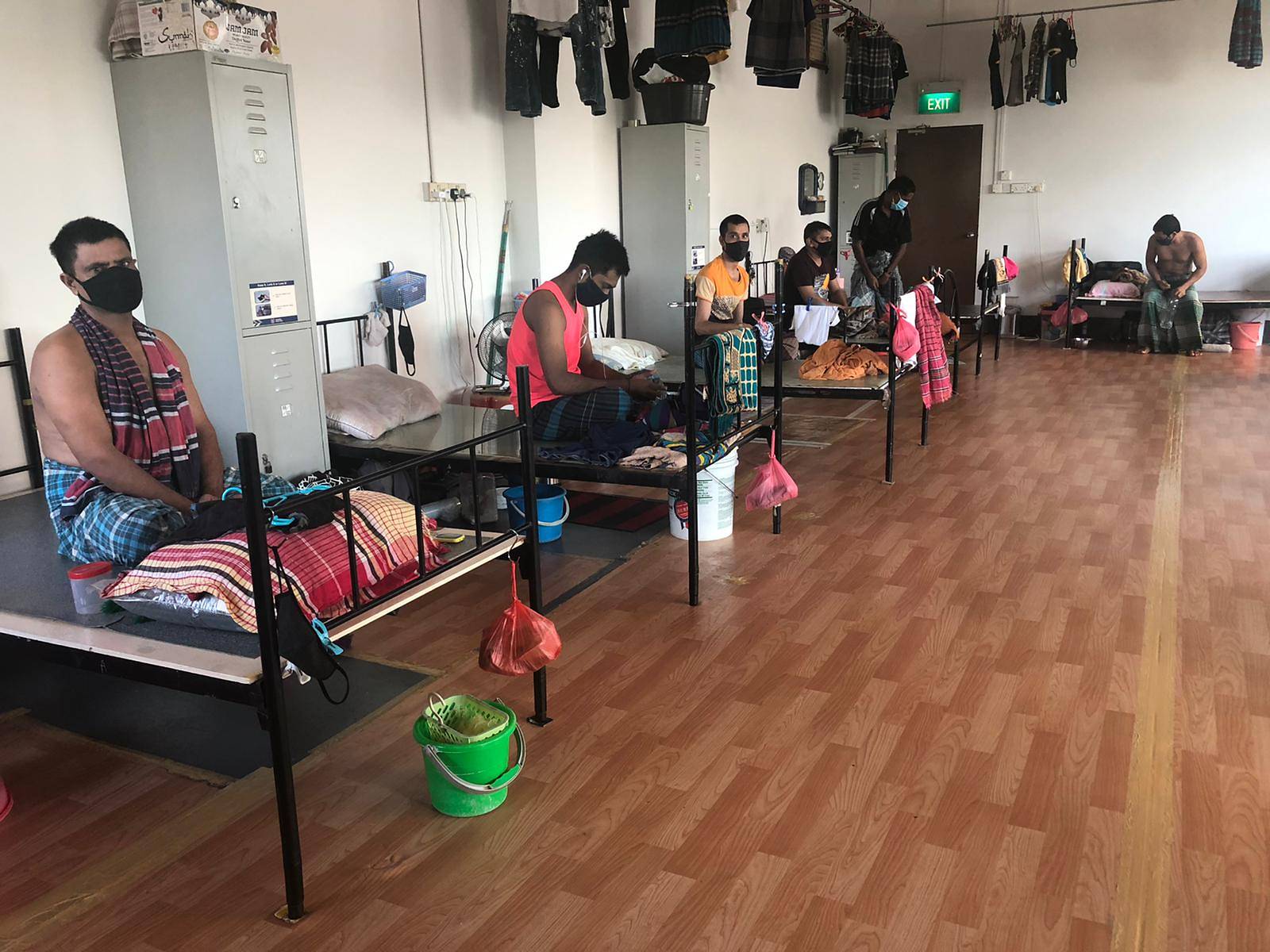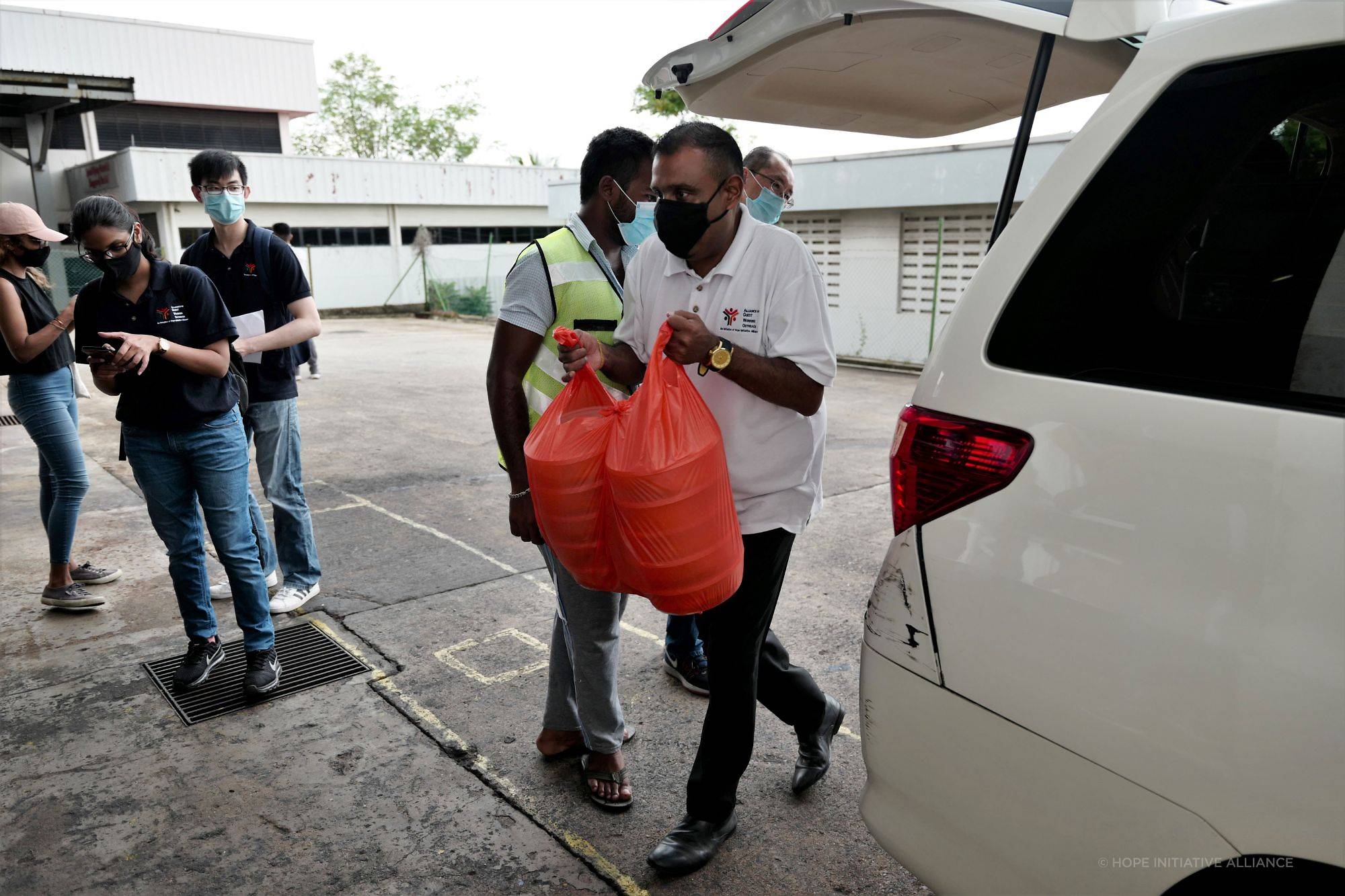SINGAPORE: While most people stayed at home during the “circuit breaker”, Mr Lim Han Eng was living at his factory with about 180 foreign workers.
As construction work ground to a halt, the 59-year-old owner of Aik San Construction took up the role of manager at his factory-converted dormitory.
“This is my rice bowl, I have to get through this with my workers. This is the dormitory for my own company,” he told CNA in an interview conducted in Mandarin.
“Honestly speaking, no one is willing to do this job, as the virus is spreading mainly in the dormitories … so the only way was for me to do it myself.”
Mr Lim Han Eng, founder of Aik San Group, is living at his factory-converted dormitory with his workers while they are in quarantine. (Photo courtesy of Lim Han Eng)
There are more than 1,200 factory-converted dormitories housing nearly 100,000 workers in Singapore. They complement 43 purpose-built dormitories with 3,000 to 25,000 workers each, housing about 200,000 migrant workers altogether. Another 20,000 workers live in temporary quarters within construction sites.
The vast majority of COVID-19 cases in Singapore have been in foreign worker dormitories, and hundreds of new cases are being found daily even as infections in the general community have declined.
READ: Singapore reports 517 new COVID-19 cases, including 15 asymptomatic cases in the community
Two dormitories were first declared isolation areas on Apr 5, with dozens more gazetted since then. Seventy-seven dormitories are COVID-19 clusters as of Wednesday, including nearly all of the 43 purpose-built dorms.
Dedicated teams have been sent to help manage larger dormitories, with another 127 mobile Forward Assurance and Support Teams providing support to factory-converted dormitories, construction temporary quarters and workers in private residences.
Authorities have stipulated that employers need to provide food and daily necessities to their workers, and have to continue paying their salaries. There are also stepped up hygiene and safety guidelines that the dormitories have to follow.
READ: COVID-19: Factory-converted dormitory in Sungei Kadut declared as isolation area
READ: Situation at larger foreign worker dormitories stable, but COVID-19 picture in smaller dorms ‘mixed’: Josephine Teo
On Apr 21, Manpower Minister Josephine Teo said that all migrant workers living at dormitories would have to stop moving in and out of the dormitories. Even as the situation at the larger dormitories stabilised, the conditions at smaller dorms were still “mixed”, Mrs Teo had said in Parliament on May 4.
While Singapore exited its circuit breaker period on Jun 2, most workers have to continue staying in, as only those who are cleared of COVID-19 infection can resume work. In Phase 1 of re-opening, which the country is currently in, the cleared workers can only leave their dormitories for work.
“DIFFERENT RULES EVERY DAY”
Mr Lim said that besides the daily maintenance of the dormitory, he has had to communicate quarantine rules to the workers.
He’s organised a team of about 10 workers to help him, and sweetened the deal by giving them more pay. The daily tasks include cleaning the toilets and clearing the rubbish regularly, as well as arranging for meals and snacks for the workers.
“The Government is issuing different rules and regulations almost every day, which the workers don’t really understand … they don’t know what they can do and what they should not do. Someone here needs to understand and let them know all this,” said Mr Lim.

Workers of Aik San Group at a factory-converted dormitory. (Photo courtesy of Lim Han Eng)
A positive side effect is that he and his workers have become closer, he said.
“Normally we are working and everyone is very busy … under quarantine, we all have time. We tell each other stories, they talk about their hometowns and families. We also tell jokes so everyone can relax,” he said. He also tells them how he started his company and tries to share life lessons with them.
So far, there has been one worker infected with COVID-19 at his dormitory who was sent for treatment, while those who had been in close contact with him were taken to a hotel to be isolated. He also sends additional food and other essentials to his workers living at the hotel.
“I hope that they will be touched and work harder after this outbreak,” he said.
“NO BREAK FOR ME”: DORM OPERATOR
Some factory-converted dormitory operators and managers CNA spoke to said it’s been a challenging time for them.
“Every day, I’m in Tuas – all the 60 days, no break for me,” said Ms Sowmia Latha who runs a few dormitories housing more than 600 workers mainly in construction companies and shipyards.
Some of them are employed by her engineering firm, while she also provides accommodation for other firms. Most of her staff who are not in dormitories are on stay-home notices, she said.
READ: COVID-19: Battling fear and boredom, migrant workers grapple with isolation in dormitories
Mr Chelladurai Dhanasekaran, who is helping Ms Latha manage the dorms after serving his notice, said that his workload has increased a great deal.
Their next challenge is to figure out how to put recovered workers back to work, and housing the workers under new regulations issued by the Manpower Ministry on Monday, which requires all dormitories to give each worker more space, she said.
COVID-19: Singapore to build new dormitories with improved living standards for migrant workers
READ: Recovered from COVID-19, migrant workers live on a cruise ship and in an HDB flat
At one dormitory, there were about 100 cases of COVID-19 over the last month and the workers have mostly recovered, said Mr Dhanasekaran. The dormitory has to prepare to receive the workers who are returning from community care facilities such as Changi Exhibition Centre.
“There’s a lot of work for me … we need to take care of the workers day and night,” he said.
Dorm operators say that the majority of the workers are from Bangladesh and India, with a small number from other countries, like China, Thailand and Myanmar.
“SPREADS LIKE WILDFIRE”
Mr Eugene Aw, dormitory business director for RT Group, said it was a mad scramble at first to “ramp up” the management of five dormitories with about 300 to 500 workers each.
“Suddenly you had up to 500 workers cooped inside the dormitories and no one is supposed to come out,” he said. “You had to do a lot of distribution of food, of materials, increase the trash disposal and cleaning of common areas … One of the biggest challenges was to find more manpower.”
They hired two more supervisors, while setting up communication channels with the workers by starting WhatsApp groups and appointing representatives among them to help with co-ordination.
“The planning of it on paper is very easy to say but the execution is not so easy … some employers they were caught off-guard, they didn’t prepare, and suddenly the Government said: No more cooking. Some couldn’t react fast enough,” he said.
Explore our interactive: All the COVID-19 clusters at foreign worker dormitories and construction sites
READ: Singapore’s circuit breaker and beyond – Timeline of the COVID-19 reality
When the situation stabilised, the mass swabbing began, and they had to monitor the health of the workers. He saw first-hand how infectious the coronavirus could be: “It really spreads like wildfire. If one person reports positive symptoms, it can then suddenly mushroom to 100 people.”
They too, have to prepare for the re-entry of the “cleared” workers into the workforce, as well as adapt to changes to dormitory regulations.
“I really salute my guys … they could very easily have given up,” he said of his dormitory supervisors, maintenance workers and cleaners. “Not every Singaporean or every worker is willing to put themselves into such a situation, and we are right at the front lines.
“We are thankful that a lot of charity organisations stepped in and on our own end we supplemented when employers couldn’t supply (food).”
SOME WORKERS LEFT IN THE LURCH
At one point, the Alliance of Guest Worker Outreach (AGWO) was providing about 20,000 meals a day to the workers who were mostly confined to factory-converted dormitories, said chairman Sam Gift Stephen.
As employers rushed to meet the needs of the workers, this number has fallen and is hovering around 15,000 meals a day. They are looking out for 267 dormitories, and providing meals to more than 110 as of Tuesday, he said.

Alliance of Guest Workers Outreach chairman Sam Gift Stephen delivers food to migrant workers. (Photo: Hope Initiative Alliance)
“Some of the employers pick up the tab and pay for the food, but there’s a big majority who say they can’t. They don’t have the financial muscle to do it, they don’t have the bandwidth to take care of the worker,” he said.
For some employers, they gradually take over the food catering one meal at a time, so it is more manageable, he said.
AGWO has also started an “adopt-a-dorm” programme which has seen about 60 dormitories taken under the wing of volunteers or organisations.
READ: About 80 breaches found at foreign worker dormitories every year: MOM
“We also do counselling and befriending, one of the problems we found was many of them are depressed, many of them have become very frustrated. Somehow there is a lack of information being fed to the factory-converted dorms.”
For example, early on, some workers did not know that employers were required to provide catered meals to them, and on Jun 2, many did not know they still could go out after circuit breaker ended, he said.
Many fear that they may not have a job after the pandemic, while some are worried about their family back home but are unable to return because most flights have been cancelled.
Migrant workers living in factory-converted dormitories in particular face tough conditions of limited space and the lack of a proper logistical set-up, unlike residents in purpose-built dorms. Volunteer groups step in, to arrange meal deliveries and check on their needs.
To keep their spirits up, the non-government organisation ran fitness competitions, giving a mobile phone to a worker who did the most push-ups, and is conducting English classes via Zoom.
“THE WHOLE SPECTRUM EXISTS”
In some extreme cases, the workers were unable to reach their bosses, he said. Ms Ruchi Trivedi who is a lead volunteer at ItsRainingRainCoats (IRR), another NGO helping migrant workers, has also come across such cases.
IRR has distributed tens of thousands of meals, fruit, essentials, SIM cards and other items to migrant workers through this crisis. The NGO has expanded its network of volunteers from about 200 to almost 500 during this period.
There have also been employers who approached them to sign their workers up for virtual English lessons conducted by their volunteers, a programme called MadWish, which IRR had launched before the circuit breaker.
“To be fair, the whole spectrum of employers exists. If there are FCDs that are doing okay, they won’t call us. And we’ve actually reached out to few who told us they’re doing okay – especially if the employer of the workers is responsible – but those that lack support do reach out to us for help, and we do our best to help them” she said.
Mr Rubel, a worker who lives at a dormitory at Tuas View Square, told CNA that he has been getting meals, fruit and other essentials, although he cannot go out.
“Now (the) situation is good, still our dormitory (is) safe,” he said in a WhatsApp message. “Thanks for Singapore and Singaporean all people for helping.”
BOOKMARK THIS: Our comprehensive coverage of the coronavirus outbreak and its developments
Download our app or subscribe to our Telegram channel for the latest updates on the coronavirus outbreak: https://cna.asia/telegram




